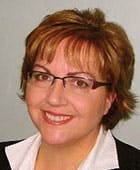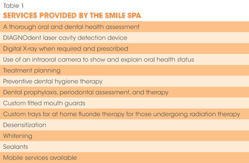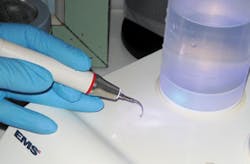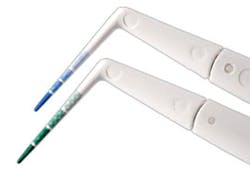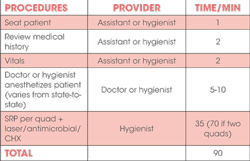Independent Canadian hygienist builds practice based on her beliefs
By Lynne Slim, RDH, BSDH, MSDHToronto has been in the news a lot lately, but for an unwelcomed reason. The Canadian city's mayor has been in the spotlight for his various rants and slurring of words, and he loves to talk about his minor setbacks. In 2013, Rob Ford pledged to clean up his act after a crack-smoking scandal, and I was travelling near Toronto when I listened to these reports on the local news. However, instead of focusing on the bad news and controversial comments, I was in Canada to write about something positive, highlighting the eco-friendly practice of Nancy Johnston.
Nancy Johnston warmed my dental hygiene soul, and she introduced me to one province's established standards of qualification and practice. Dental hygiene is a self-regulated profession in most Canadian provinces, and provincial legislation grants power to the dental hygiene profession in regulating the practice of dental hygiene. Ontario in 2007 allowed hygienists to practice without direct supervision of a dentist.
I received a very warm welcome from Nancy who met me at the Toronto Pearson International Airport.
------------------------------------------------------------
Consider reading these articles
- The business of public health dental hygiene endorsement
- Perry O'Donnell and dirty laundry
- Kiancare: An RDHAP visits homes to give clients access to care
------------------------------------------------------------
Winter had not yet made its presence felt in the way that makes uncovered skin beg for mercy, but I did notice some strong winds, especially along the shore of Lake Ontario. Nancy drove me from the airport to her comfortable home in Bradford, which is a quaint farming community located on the Holland River north of Toronto. I was warmly greeted by Nancy's daughter, Charlotte, and their two large, rambunctious dogs that rule the roost and wanted to sleep in my bed with me. Since I'm a dog lover, I didn't have the heart to close the bedroom door at night so it was a bit crowded when I wanted to stretch out under the duvet.
Just as I've never seen milk packaged in a plastic bag (a Canadian oddity), I've also never experienced a dental hygiene practice in a dental hygienist's home. What an unexpected treat it was for me to view an operatory that way. I was ready to pack my possessions in Atlanta and find a way to relocate immediately! Just imagine going from breakfast in your comfortable kitchen to the operatory without leaving your home in frigid temperatures.
Every hygienist I've interviewed is unique based on education and experiences, and Nancy is no exception. Nancy started her independent practice in 2008 and named it The Smile Spa (www.thesmilespa.ca). Insurance companies were slow to recognize dental hygiene fee codes in the beginning. In Ontario, hygienists cannot currently offer local anesthesia, and need a written prescription from a dentist to take radiographs.
Knowing she can treat her clients in a way that would be most beneficial to them was a major motivation in how she customized The Smile Spa. As a proud member of the Eco-Dentistry Association, she wanted to incorporate high technology that meshed with her environmental objectives. In 2013, she attended the first Green Dentistry Conference in Provo, Utah, to learn more about eco-friendly services.
She loves being a pioneer in this movement, and her devotion to environmental concepts already shows in her home operatory. She tries not to use disposables whenever possible but instead she uses eco-friendly alternatives that can also be cost-effective. Eco-friendly dental products include the use of biodegradable and biocompatible cleaning products, sterilizable stainless steel cups instead of paper cups, and the use of natural fiber products instead of wasteful and environmentally "unfriendly" plastic-backed paper bibs.
Nancy and others in the Eco-Dentistry Association are committed to improving the working environment for staff and clients in dental offices by reducing the environmental impact of toxic chemicals and promoting overall wellness whenever possible.
Nancy said Dr. Richard Ehrlich, a former employer, had a positive influence on her career, and she credits him with introducing her to the eco-conscious movement. Dr. Ehrlich graduated from the University of Toronto and maintains a private practice in Palgrave, Ontario, called The Elm Tree Dental Clinic. His practice has been presented with many environmental awards and is dedicated to eco-conscious, minimally invasive dentistry. In viewing his website (www.elmtreedental.com), I noticed that he even bikes or skis to work to keep fit and have less of a negative impact on the environment.
Nancy's gentle and inquisitive soul likes to focus on creating a positive, nurturing atmosphere where clients relax comfortably in her cozy operatory chair. Zen music is usually playing in the background, and aromatherapy is offered to help clients unwind and feel calm. She's all about changing the hygiene experience not only for the client but also for herself as the caregiver.
No longer a "slave to the daily schedule," she might reserve three hours for one client, and she rarely has to feel rushed for time. (Dental hygienists, as we already know, are not immune to the ravaging effects of stress on their own bodies.) In a society that sometimes praises those who work 60 hours/week and one that seems to love money more than treating people right, Nancy's philosophy towards work/family life is refreshing. She is drawn to the calming experience of meditation in her daily routine in an attempt to nurture inner peace. A home operatory allows her to make this happen.
Nancy's been practicing for about 24 years, and she has been independent for the last five years. She received specialized education in Switzerland at Electro Medical Systems (EMS) as a trainer and I attended one of her lectures in addition to spending quality time with her at her home practice. She now teaches on behalf of a company named Rdhu (www.rdhu.ca) that provides experiential learning (hands-on) to dental hygienists in Canada onsite and online. Rdhu was created for dental hygienists by dental hygienists, and it has over 8,000 members.
In Nancy's instrumentation course, her message is all about an "empowered" role for hygienists and becoming a change agent for clients. She refers to an elderly aunt who entertained soldiers during World War II by singing and dancing to give them some diversion from the reality and brutality of the battlefield. Nancy tries to change one client at a time by moving them from disease to a healthier state, and she's adopted principles of evidence-based dental hygiene coupled with the principle of eco-friendliness. One of the biggest frustrations of most practicing hygienists is lack of time and cheap equipment, which are things Nancy doesn't have to worry about. Instead, she offers an alternative to dental franchises and doesn't have to be part of the "demands of corporate structure."
Individualizing Care
Let's look at some of the dental hygiene services Nancy provides (Table 1) and discuss how she makes a difference. She loves today's focus on oral/systemic health but she's careful not to jump from "links" to "cause and effect" without grading evidence and keeping a watchful eye on the research. She looks "far beyond the mouth" in assessing her patient's health and spends a lot of time on patient assessment. Nancy's also passionate about furthering interprofessional collaboration involving dentists, dental specialists, naturopathic doctors, and nurses. She feels her particular strength is a commitment to individualizing care and optimizing outcomes.
For example, by investing in high quality equipment, she can focus on client outcomes. We spent a lot of time discussing her periodontal protocol. Chemicals are not always necessary to make patients healthier, she says, and she'd rather talk about preventive focused interventions such as dietary changes, pH levels, and obesity as risk factors for disease than systemic antibiotics. She uses high-end Hu-Friedy/EMS technology and her proportion of time has shifted away from hand curettes in favour of ultrasonics for debridement because of demonstrated efficiency.
Hu-Friedy/EMS Swiss piezo, Air-Flow and Perio-Flow technology did not have a big presence in the United States until recently, but are popular in Canada, Europe, and in Asia. (A new strategic alliance between Hu-Friedy and EMS may bring about a new interest in EMS technology to the United States.) Nancy's Hu-Friedy/EMS Air Flow Master Piezon delivers a variety of treatment applications with power differentiation. The handpiece with LED is lightweight and delivers circular light (see Figure 1), and irrigant flow can be adjusted by the practitioner. Medicaments like chlorhexidine can be added with the bottle system. Piezo tips are high quality, thin, and designed for any application a hygienist selects, including rights and lefts for subgingival scaling of molars/pre-molars, and tips with balled ends for delicate work in furcations.
What's unique about the Hu-Friedy/EMS Air-Flow Master Piezon for a hygienist is its three applications in one device. Air-Flow is air polishing with classic sodium bicarbonate or glycine powders for supragingival stain and biofilm removal. Perio-Flow (another application that is different from Air-Flow) can remove subgingival biofilm in pockets greater than 5 mm. The glycine powder is fine (small particle size), and Nancy educates hygienists how to measure the hardness (Mohs scale) for different powders. PerioSoft is a small particle size and very low on the Mohs scale. You can change the powder chambers during treatment in a simple way, and Nancy uses both Air-Flow and Perio-Flow applications. The supragingival Air-Flow uses glycine too -- so clinicians can achieve a subgingival biofilm removal up to 4-5mm with the Air-Flow nozzle -- and "soft" or PerioSoft glycine powder, which is Nancy's powder of choice. The glycine powder is less abrasive, and is a natural amino acid, which is alleged to promote the formation of collagen fibers.
Innovative technology and other useful items are prominently displayed in Nancy's operatory. She will only use the Blue Boa adaptor (www.theblueboa.com) with Otis Formeject saliva ejectors, and she says it helped her fall in love with her EMS because she could suction hands-free.
DIAGNOdent is a favored technology, especially before placing sealants, along with a new technology called UFIT. The UFIT system is a portable, non-invasive electronic device that measures blood pressure, pulse rate average, and pulse rate variability. Results are processed immediately, clearly displayed on a computer monitor, and can be transferred to the patient's physician electronically.
Nancy uses a Celestron PentaView LCD Digital Microscope, which is an inexpensive way to snap photos and record a video. She points out various microbes to her clients. Although it's not diagnostic, it helps her explain biofilm concepts in the etiology of dental caries and periodontal diseases. She finds it an invaluable component of client education, too, and loves to explain how the interactions of multiple organisms create a loosely-attached polymicrobial biofilm that resists our efforts to eradicate them and delays wound healing in subgingival pockets.
A periodontal probe that I saw in Nancy's hygiene cassette is the Hawe Neos Click-Probe. It is one of a few commercially available pressure probes for use in daily practice. The Click-Probe is plastic and perfect for probing around implants, too, with a plastic tip (diameter 0.45mm) and a force delivery system through a special magnet that will disconnect with a probing force of 0.20N (see Figure 2).
A group of over 600 "independents" in Ontario support each other and even get together occasionally. Dentists in Nancy's geographic location may be missing an opportunity to learn about independent hygienists, and they may be totally unaware of the overall experience they provide. Independents like Nancy find an alternative practice setting more satisfying and an outlet to more fully express their innate talents, value systems, and passions.
"Clients like this delivery of care, because they know we are not on commission, or trying to fill the boss's chair," Nancy said. "When we refer to a specialist or recommend that they seek dental restorative work, we feel it is in the client's best interest."
Fees for preventive services provided by a dental hygienist are available online at www.odha.on.ca/drupal/system/files/pdf/FG.2013_0.pdf.
In writing about dental hygienists, I always try to focus on what's inspiring, what's positive, and what's working. Nancy embodies all of these attributes and so is an inspiration to all of us.
LYNNE SLIM, RDH, BSDH, MSDH, is an award-winning writer who has published extensively in dental/dental hygiene journals. Lynne is the CEO of Perio C Dent, a dental practice management company that specializes in the incorporation of conservative periodontal therapy into the hygiene department of dental practices. Lynne is also the owner and moderator of the periotherapist yahoo group: www.yahoogroups.com/group/periotherapist. Lynne speaks on the topic of conservative periodontal therapy and other dental hygiene-related topics. She can be reached at [email protected] or www.periocdent.com.
References
1. Sculean A, et al. A paradigm shift in mechanical biofilm management? Subgingival air polishing: a new way to improve mechanical biofilm management in the dental practice. Quintessence Int. 2013 Jul;44(7):475-7.
2. Frühauf J, et al. Soft tissue cervicofacial emphysema after dental treatment: report of 2 cases with emphasis on the differential diagnosis of angioedema. Arch Dermatol. 2005 Nov;141(11):1437-40.
Past RDH Issues

